The mosaic-coated pillars of our hotel stretched away into the darkness of the night sky as Yaseen unloaded our bags. A trio of brown-suited bellhops, and a duo of black-suited concierges, greeted us at the 10 foot tall gate to usher us into the reception area. Credit cards were solemnly run for ‘incidentals’ and presented back to us with bowed heads and a clearly trained 2-handed, thumb and forefinger grip. This was the Palais Faraj, built in 1911 by a local judge favored by the Sultan as a home for his immediate and extended family – one year before the curtain came down on the Sultanate and the French forced the nation into a Protectorate status. So while it was only a century old, only after I later chatted with the concierge did I learn this, because the judge had a decidedly 1600’s taste in decor, following the yellow/blue/black/green mosaic style we’d seen in many of the madrasas of that time period.
We were led through numerous sitting rooms, libraries, stepping up and down cautiously in the dim light to avoid tripping over the many small changes in floor height in our path. Some areas had once been courtyards, but all these courtyards had since been covered in glass caps; Fes after all does get plenty of rain, and tourism at a hotel like this demands that guests never sully their dainty heads with wet.
Since our drive the previous day had been so long, Omar let us sleep in a bit, picking us up after our continental breakfast on the top of the building. Our view looked out over the edge of the Old City, across the Ouislane Valley, and upon the other side framed in the morning mists was a blocky, imposing beige structure called the South Tower. We’d be seeing that later.
For now, though, we’d be starting in the Old City. Omar would be our guide, and he led us down the narrowest alleys and corridors we’d seen yet, sometimes no more than half a meter wide. In some places the 400 year old buildings were practically leaning into each other over the alleys, and needed to be braced with new-looking wooden supports. Omar explained that alleys this small would never have been okay with the municipality of the time, but instead were once a single large house, but then the owner had sold it, and it had been divided into smaller and smaller parcels until only these little practical crawlspaces remained.
We saw a museum called Nejjarine, a beautiful former inn that now housed three stories worth of “stuff Moroccans have made that is made of wood.” If you can make it out of wood, there was probably some creation of that family in that museum. Musical instruments! Doors! Bridal palanquins! Mosque screens! Weapons! Islamic legal decisions! Toys! Intricately cut and painted shelves! It was quite fancy and all the signs were written in Arabic, English, and French so dad and I could browse inscriptions to our hearts’ content.
Next was another madrasa, similar to Ben Yousef that we had seen back in Marrakech. This was al-Attarine, and it was similarly beautiful with its mosaics, fresco inscriptions, and carved wood upper areas. One immediate difference I noticed between Ben Yousef and Attarine was in the student dormitory area – while the former’s rooms were darken, with windows only looking back into the hallways, these ones were well lit, with openings in the ceilings to let sunlight pour in (like the Palais Faraj, they had been capped with glass for tourism purposes), and almost, if not all, student rooms had an outside facing window. Omar said that unlike Ben Yousef, which was more of a ‘graduate school’ for students practiced enough to have already memorized the Qur’an, Attarine was made for younger children who could graduate through ‘levels’ of memorizing parts of the Qur’an before the whole thing, and also that there was more competition from other possible madrasas that wanted students, so they wanted to make the student lodgings more attractive.
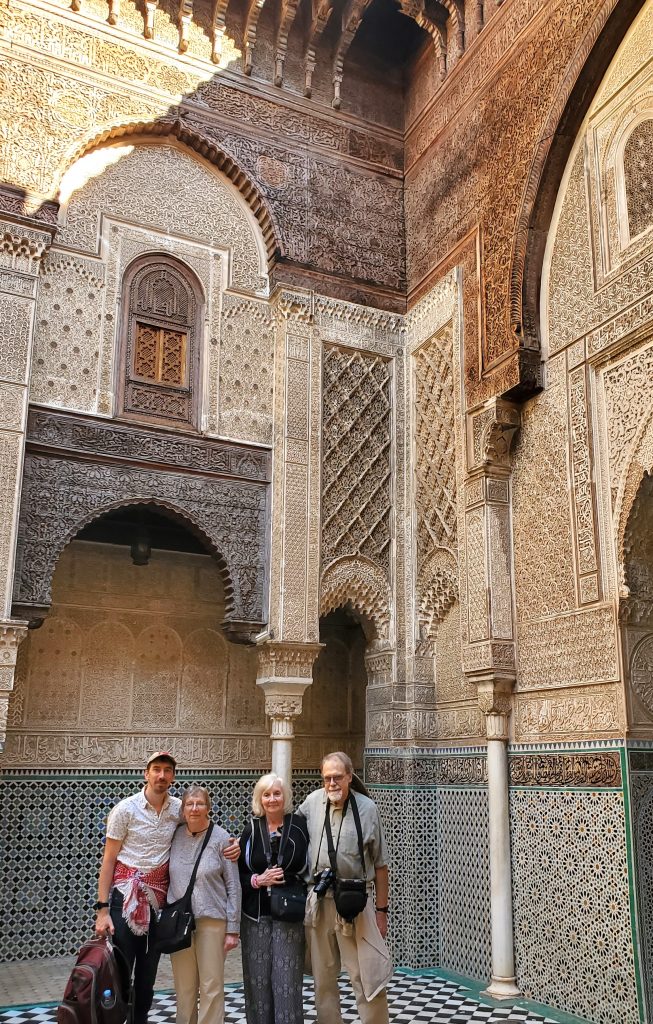
We made a couple of stops in handicraft areas; the famous tanneries which are hundreds of years old and a well-known tourist stop. Dozens of pits in a 2000 square meter courtyard emitting a smell that could be described as ‘interesting’ in the politest sense. The entrance was nondescript, a staircase through a tiny door with merely a sign that said “tanneries; looking is free!” A fellow sat on the first landing with a sack of fresh mint leaves next to him, and he smiled as he handed a sprig to each tourist, and gestured to hold them under our noses. Every wall and every passage was covered in leather goods of all types and colors; jackets, belts, and thousands of handbags. Effective insulators, we could barely hear the murmur of the hundred other tourists ahead of us as we climbed and walked through the tangled hallways to find the ‘overlook’ of the tannery pits. The men below had their trousers hitched up to their thighs and were working the leather with their feet. The employee describing the hectic work below mentioned that pigeon dung was used as part of the process too, but the smell at this point was harsh, thick, acrid, and not really describable beyond ‘it smelled like a tannery.’
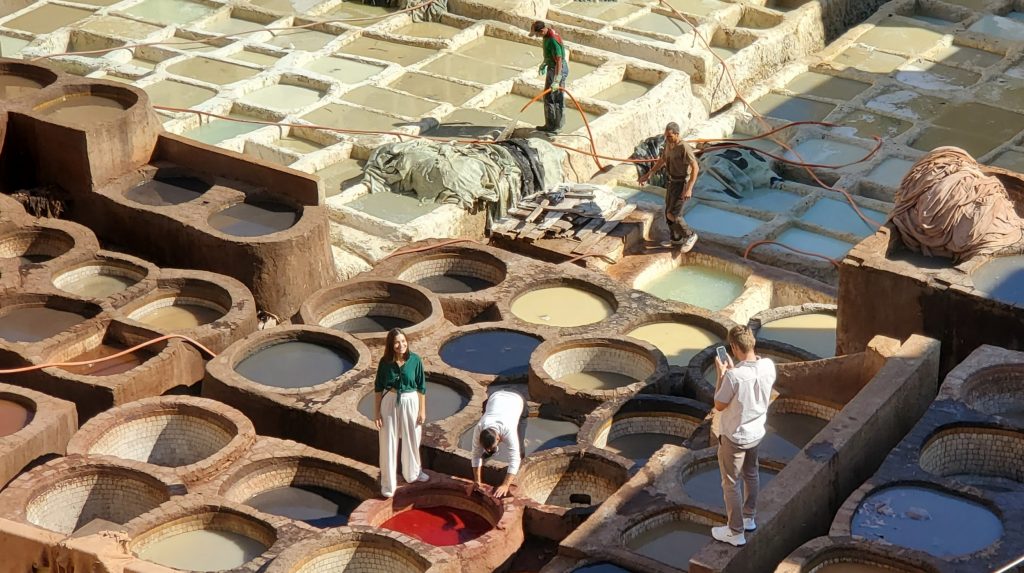
Retreating back inside (and having a brief chat with a group of middle-aged American women who I heard speaking Levantine Arabic with each other, who told me they were Jordanian-American expats on vacation and we spoke briefly about the conflict in Palestine), we continued to the next handicraft shop. This was a textile group, owned by a family, but here instead of vertical looms that in Berber culture were primarily handled by women, these were mechanical foot-pedal looms that were piloted by men. I acquired some gifts for niece and wife here, and the English-speaking “handler” that was assigned to us seemed more than happy to assist. At the checkout counter, the only-Arabic speaking clerk asked how I spoke (bad) Arabic with her, and I gave her the usual Jordan+Iraqi refugees backstory. She then proceeded to tell the handler she was dropping the price on a particular piece by another 200 dirhams, or about 20 dollars. The handler led me back downstairs, gestured to a side aisle and said, “such a good price you got, so many tourists here, they learn Arabic already from anywhere – come on, give me a tip.” I gaped a little at his audacity. “You want a tip… because you think you got me a good price?” He agreed that it was the right thing to do. Back on the ground floor, I consulted with Omar about this. I’d never had the pleasure of being in a retail shop in which sales clerks wanted tips in exchange for ‘bargains.’ Omar looked uncomfortable but said that yes, he had seen it before – but I should never feel obligated to tip for anything in Morocco. I gave the clerk a couple dollars, like 20 dirham, just to be rid of his wheedling smile. It was some nice looking textiles, but ugh, really?
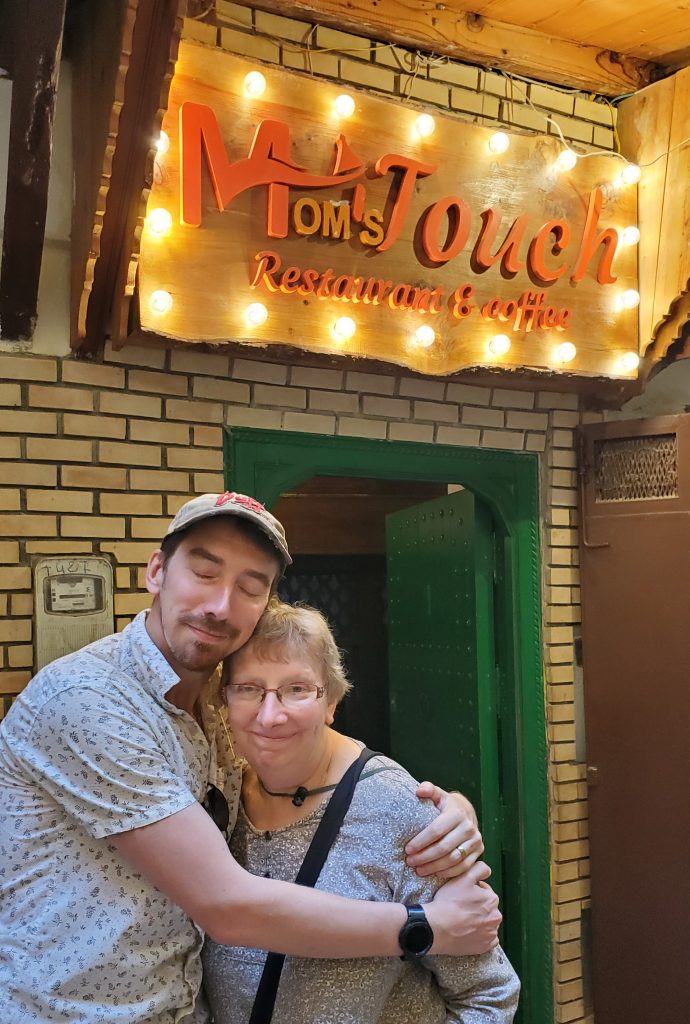
The main event of the afternoon was also a handicraft shop, but it was the one we’d all been waiting for – Fes’s premiere pottery shop for training young people, creating new works, and selling them. Our guide was Idriss (the same as the first Moroccan king of the first dynasty), a gentile old man who clearly had worked his way up from the bottom in this cooperative up to a managerial and now, tour guide role. Outside the building in the cool yet steady November sunlight, a couple dozen young shebab (dudes) were carting wheelbarrows of muddy clay about from pits, watering said pits, forming the clay into thin mosaic tiles or larger bricks, and drying them out. Idriss showed the ‘old kiln’ which had originally been fired with olive pits and wood and had handled the thick bricks, which needed the high temperatures produced. “That was in the old days,” he demurred, “but now there are new pollution laws in the city so we can’t use this kiln anymore; we still make the bricks here, but we take them outside the city to a second location where we can fire them.” Making the thinner mosaic tiles allowed for a lower temperature, which could be achieved with gas instead of wood. They still had a ‘gas chamber’ onsite (“wait, what did he say?” said Betsy. It’s for the mosaic tiles, I told her. “Oh whew, I thought this was a very different tour,” she replied) but due to the some leaky pipes and tanks within the room the younger kiln squatted, we could only bear to be inside for a half minute to look at it before quickly exiting with eyes watering.
Within the next well-lit room, men and women hunched forward over painting work with boxes of freshly fired plates, bowls, cups, and other errata before them. They were using ink pens and brushes to quickly create elaborate tracery on them, turning it quickly to check their work and make sure nothing had smudged, and set it aside. Idriss stood behind us with arms folded as we watched for a minute. “I’m the quality control,” he laughed, “I check almost all the pieces they make.”
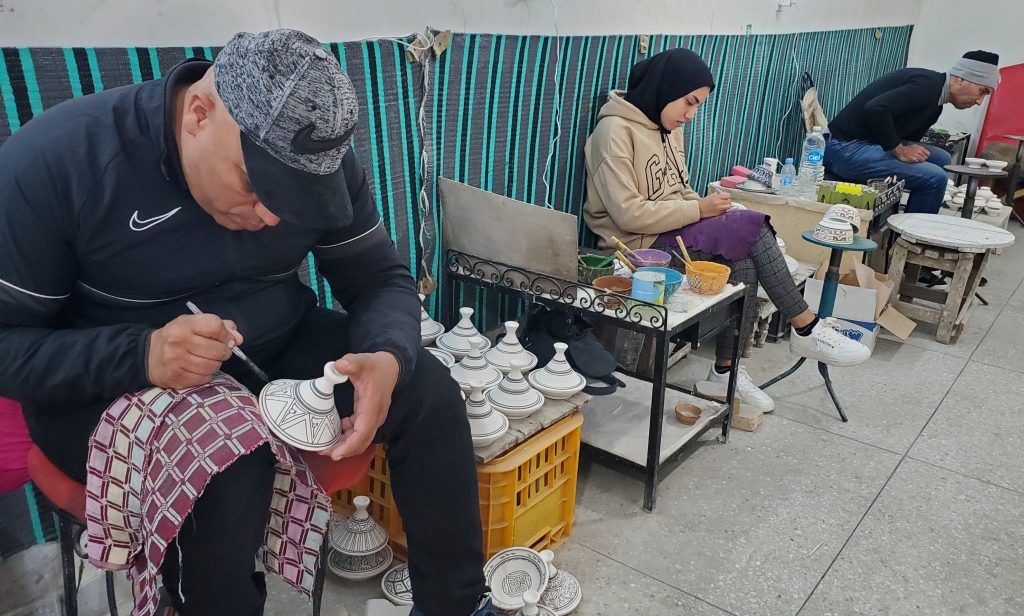
He took us through the mosaic creation area too, where people with plenty of money had entire custom porch tables and desks created out of Zelij, the Arabesque style of creating large repeating patterns of mosaic out of small pieces of ceramic tile. The design would be made first and individual pieces sketched out, enameled with particular colors, then fired. An artist would then very carefully use a fine tipped hammer and chisel to break the small bits of shaped ceramic out into their individual pieces. They’d then align them on the floor, bottom-up (your memory had to be REAL good for this I guess since you couldn’t see the color of any of the pieces you’d positioned), inside the metal frame of whatever shaped table you wanted. Then liquid fiberglass would be poured over the set tiles to finalize the position, then it’d be fired again to solidify the fiberglass and complete the product. A very painstaking procedure that afforded no mistakes.
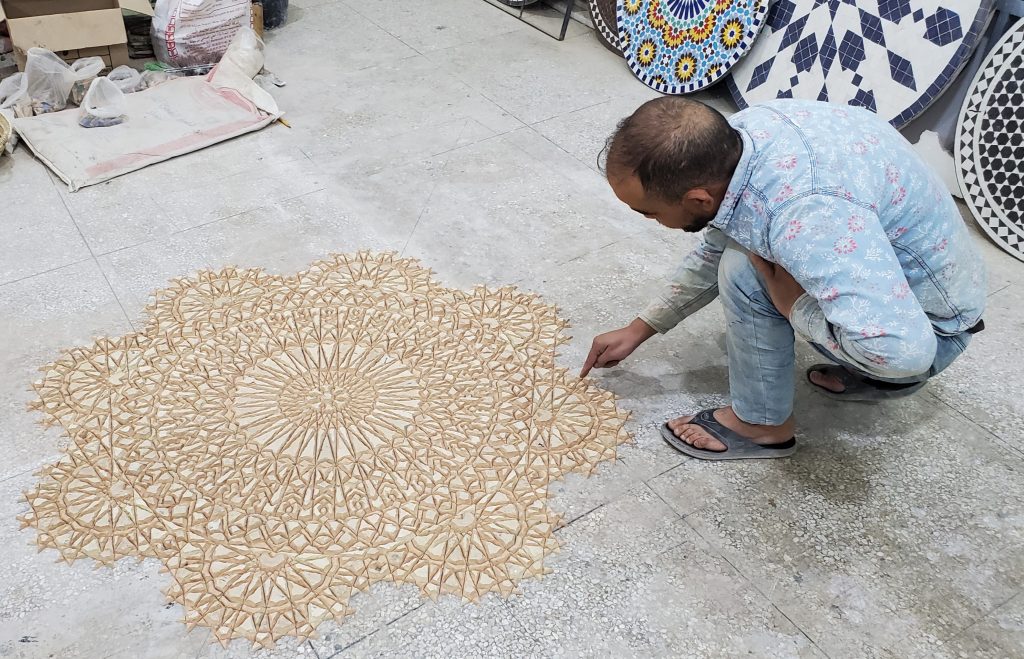
Then it was onto the gift shops. First, on the ground floor, the ‘fancy’ room which had to be one of the most expensive, per-square-meter, rooms I’d ever been in. This room was filled with pottery that had been inlaid with Moroccan silver and carved camel bone. Idriss said that due to less-honorable employees, they no longer did the silver and bone in house, instead completing the tilework here at this building, weighing them, then handing over the unfinished pottery to the bone or silver artisans for them to work their magic on. Then the pieces would be returned, weighed again, and the third party artists would be paid per gram of bone or silver applied. The intricate silver-wrought or bone-carving work upon these extra materials had their price per piece agreed on ahead of time, and quality-checked by people like Idriss and his fellow top-level managers.
At the checkout line, Idriss drove a hard bargain with his customers. He was willing to drop the listed prices for group purchases, but not by much. He worked quickly with his calculator to show us he was dropping about 10% apiece. I was only interested in buying a soap dish to replace the 20 year old K-Mart (yeah, it was THAT old) dish in our bathroom, but I paired it with a second larger dish to catch water draining through the holes of the soap’s resting place. He dropped the combined price of the two pieces another 5% for me – after I chatted with the severe-looking checkout lady in Arabic. A pattern is being established; as in Jordan, Moroccans seem to love it when ajaanib (foreigners) chat with them in their own language. Works for me, since I was going to do it anyway.
We had dinner in the Palais Faraj after ending our tour and bidding farewell to Yaseen and Omar. While this place is probably (?) one of the more expensive hotels and restaurants in town, the prices are still very reasonable in general by American standards, and extremely good compared with a hotel of a similar caliber in the States. For instance, the steak tenderloin I had was merely 230 dirhams; a little less than 23 dollars, and it was excellent (if small; but about on par if you were to order a steak in any upscale restaurant these days where quality and presentation is considered more important than “fill this man’s arteries with beef cholesterol ASAP”). The wine was astronomical though; even a single 2oz pour was about 10 dollars. Alcohol was getting harder to find the farther north we traveled, and prices in hotels (solely from government taxation, the servers apologetically told me) were climbing as well. Every restaurant we visited north of Marrakech simply didn’t it in their menus, either. I used this as a good excuse to abstain.
Well, except for the two six packs of Casablanca beer I picked up from the Carrefour earlier that same evening as the rest of the group went home. I figured that with 6 days left on the trip, that way I could have a couple a night without needing to pay restaurant prices, if I could even find a restaurant that carried them. Omar and Yaseen’s hotel was on the outskirts of the city, and they offered to drop me off on the way, to which I happily agreed. The French chain store’s alcohol department was absolutely packed with Moroccans, spilling out the door into the mall’s outer walkways. I didn’t hear a lick of French, Spanish, or English – everything was Dareeja Arabic. Beer prices were similar to Wisconsin for ‘local brews’ like Casablanca; approximately $1 per 12oz can. Tourists from pricier non-Wisconsin states would even have been pleasantly surprised as to how cheap cans and 6-packs were. Remembering that 15 years ago in Jordan, I was told that the Hashemite government imposed a 300% tax on alcohol, I felt happy to take what I could get!
On our second day in Fes, Sunday, Omar first took us to the Jewish cemetery, followed by the gates of the royal palace right next door. The cemetery had been recently retrofitted by generous donors and it was filled with little smokestacks next to the rounded white graves. Inside each little ‘kiln’ were groups of white candles. The day before had been Shabat (Omar had specifically timed the visit to not be on Shabat, when the cemetery was closed to non-Jews) and clearly, friends and family had come by to ‘light a candle in memory’ of their kin. Across the street was one of the Alooweet (3lowit in Arabeeze) dynasty’s many palaces, always placed near the Jewish section of each ancient city to show the populace that the Jews were protected by the crown. We couldn’t go in, of course, since this was an active location. Omar embraced a friend near the street, a man with a 2 day stubble, jeans, and a puffy vest, like what Marty McFly wears in Back to the Future. He had a single earpiece in his ear. Omar said quietly to me, “he’s the head of the secret police here around the palace, I see him here whenever I take tours and he knows me too. He walks all over this area watching the tourists and communicating with the uniformed guards and police.” We would see him several more times, almost coming out of nowhere and reappearing with a smile to slap Omar on the shoulder and rapidly chat with him about something, then disappear almost as quickly into the crowd.
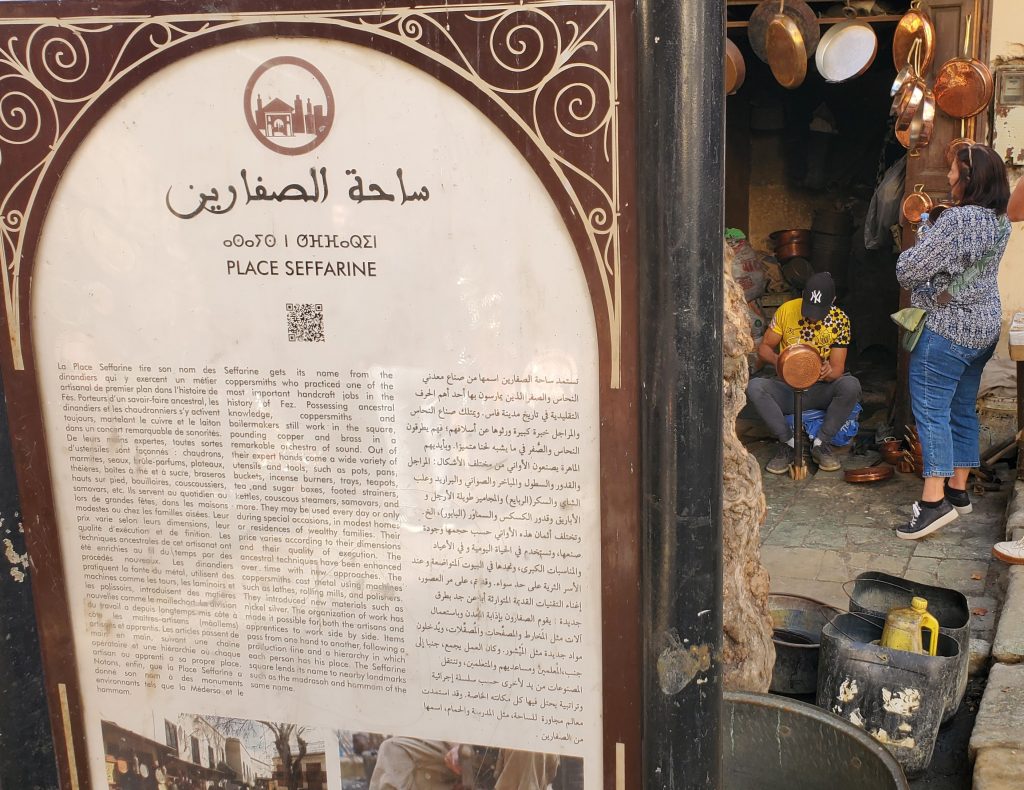
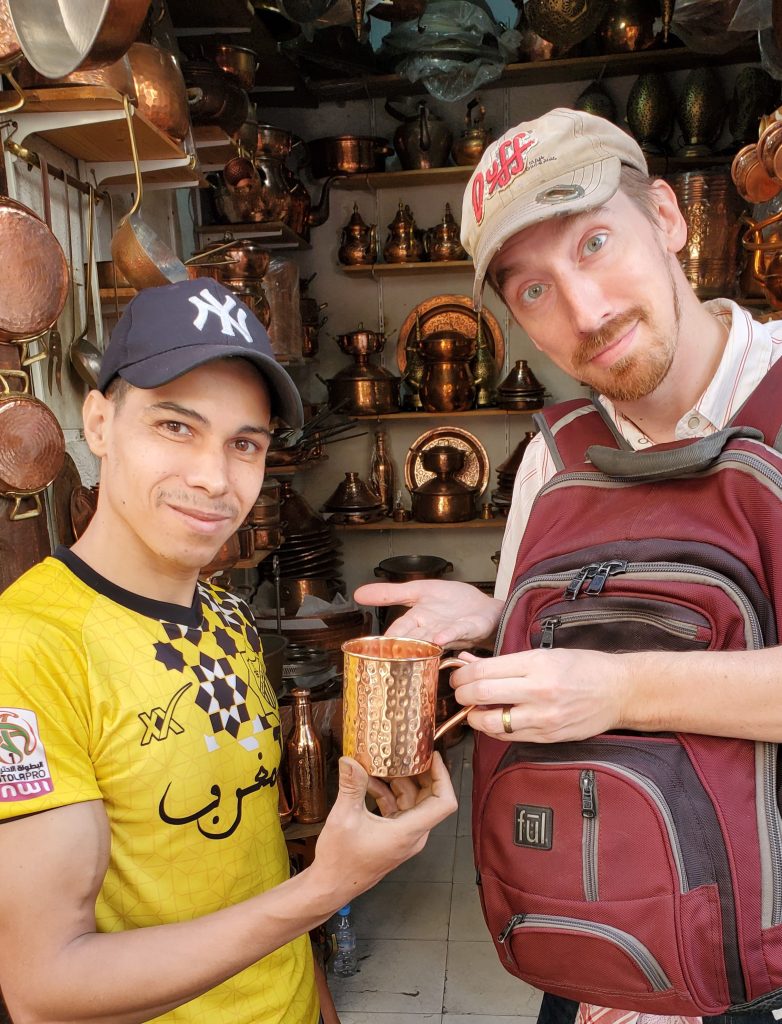
The van chugged up the steep hill to the aforementioned South Tower, Borj al Jenoob, which was not internally open to the public (“perhaps it will be a museum someday, but there’s no funding for it yet,” said Omar) but had some excellent vistas across Ouislane Valley to the almost identical North Tower. These had been built by the earliest colonists, the Portuguese, to overlook the small village of Fes long before the French or Spanish moved in to further exploit the native populace. I was surprised by the open green hills to the west of us, undeveloped land that seemed empty of agriculture, commerce, or residential build-up – just green fields with a splash of crooked olive trees on them, with the massive skyrises of “New Fes” (which we did not visit at all in our two days; a typical urban city like any other) wreathed in smog to the southwest behind them. In Amman, another very hilly city like Fes, any prime land like this would have been bought up and commercialized, and this land we were seeing here was far more fertile looking than the white gravel and sand of Amman. Was it purposely held by the kingdom or municipality to keep it green and clear so that the residents of Old Fes would have some nature to look out upon? Omar didn’t know.
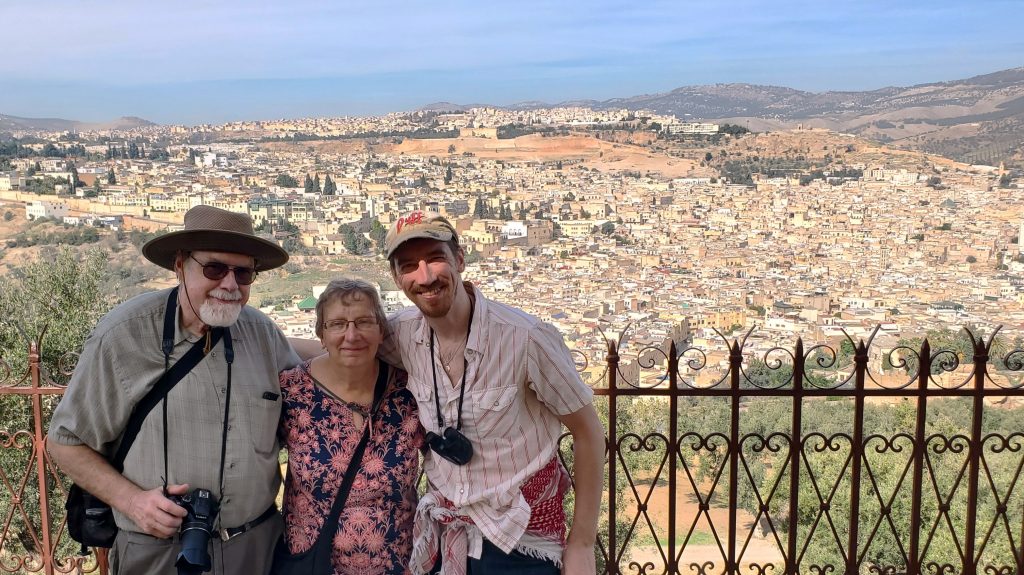
Our final activity of Fes was a food tour + cooking class, hosted at Palais Amani, another similarly fancy hotel to Palais Faraj, but instead of being on the outskirts and rising above the crowded ancient souqs, it was right in the middle of them. We were escorted inside the riad with its bubbling fountain and entertained by “BaMohammad”, an elderly mustachioed and bespectacled gentleman who, for all intents and purposes, was the loveable mascot of the hotel who made the tea for every new guest. When our cooking teacher of the evening, Lubna, joined us, she said that “Ba Mohammad” would be slang for “Abu Mohammad” or the father of an eldest son named Mohammad, but she knew for a fact he didn’t have a son named Mohammad. She and I jokingly interrogated him and he revealed that while he didn’t have a son named Mohammad, he had a grandson of that name, and hoped that would suffice, and please, just call him BaMohammad, he really just wants that nickname!
Lubna’s mastery of English was by far the best we’d seen yet from any Moroccan. She looked to be in her mid-twenties. We asked how she’d learned it so well and with a sigh, she admitted that it was from a decade of watching the Kardashians on the internet, and that they were her idols. It’s embarrassing I know, she winced, but I’m addicted to American reality TV shows – at least it teaches me English. I was reminded of 15 years ago, when I first met Haitham, and he told me that despite having never formally studied English beyond the rudimentaries that public Jordanian schools required, he was completely fluent – all from watching pirated TV and action movies from that long-ago pre-streaming era, when 1 dinar DVDs were available on every street corner and the internet was still only slightly better than dial-up in most Arab cities.
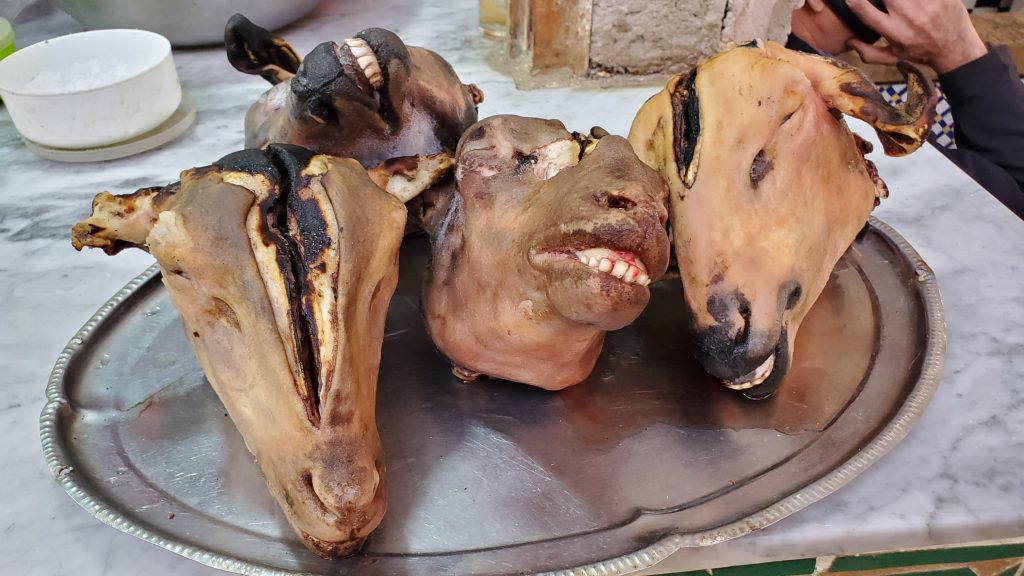
After we were joined by other tourists; 3 older Canadians and a young couple in their mid 20’s from the Netherlands that were celebrating getting their masters degrees, Lubna and her colleague, Wafa, escorted us back out into the market for some food samplings. We had some broad bean stew (I recognized it as a simpler version of Egyptian fuul medamaas) and various other snacks as we walked around the market. At the same time, we were also collecting the tomatoes, garlics, onions, and herbs we’d need to cook our menu for the evening. We finished off the market tour with a stop at “Chez Abdullah’s Tea” – an old man who’d been making a special blend of absinthe (sheba), rosemary, mint, and marjoram tea for the past 40 years. Back at the hotel, Wafa whisked our purchases off to scrub them clean and we were sent to the topmost floor of the hotel above the chaos of the market below. A typical cooking class layout was neatly laid before us – propane stoves, dishes of spices, and numerous pans.
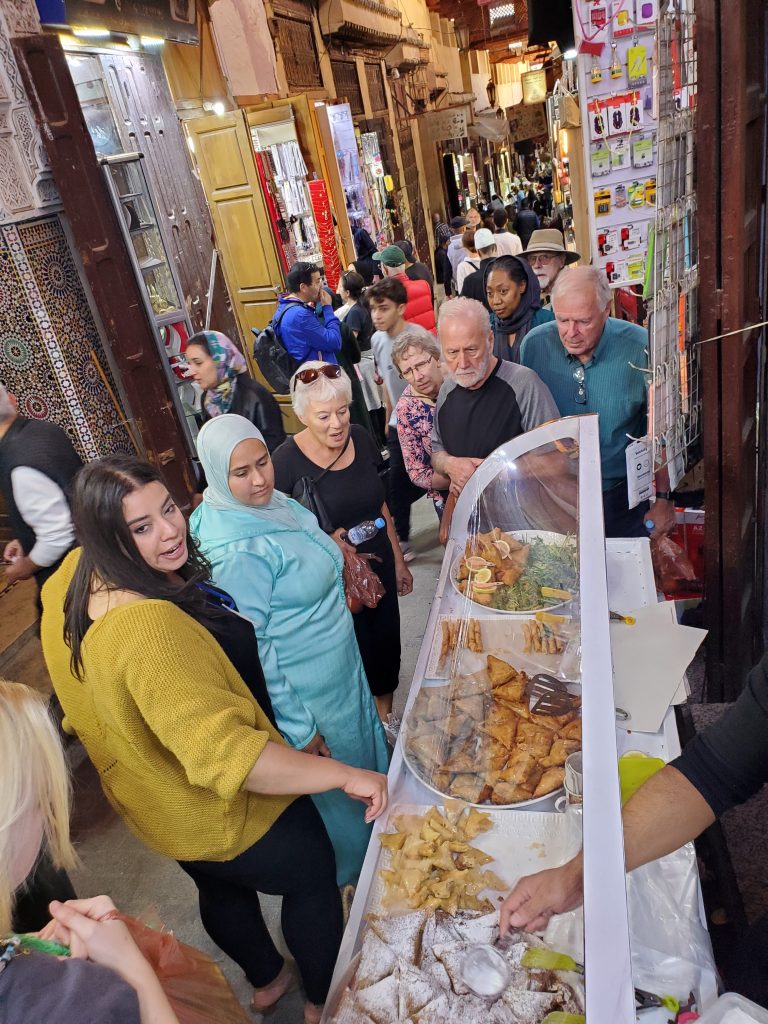
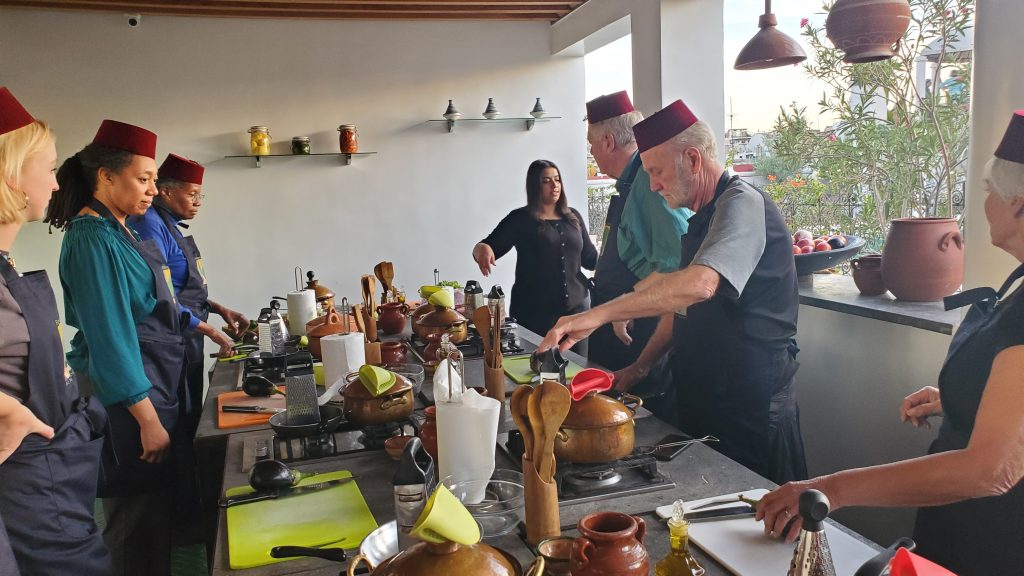
Lubna expertly guided us through constructing a chicken tagine, along with Moroccan baba ganoush – a spicier version of the classic eggplant dish. She jokingly encouraged us all to refer to each other (and her) as Chef, all night. “Place the mashed eggplant in your small pan! Yes chef?” “Yes, Chef!”. We lauded the resulting saffron-infused chicken as one of the most tender we’d had in all our time in the country. This was Connie and Nicole’s last night with us before they returned to the USA and we’d continue on further north to the final trio of cities, so we enjoyed a peaceful farewell dinner on the terrace of the Palais Amani together.
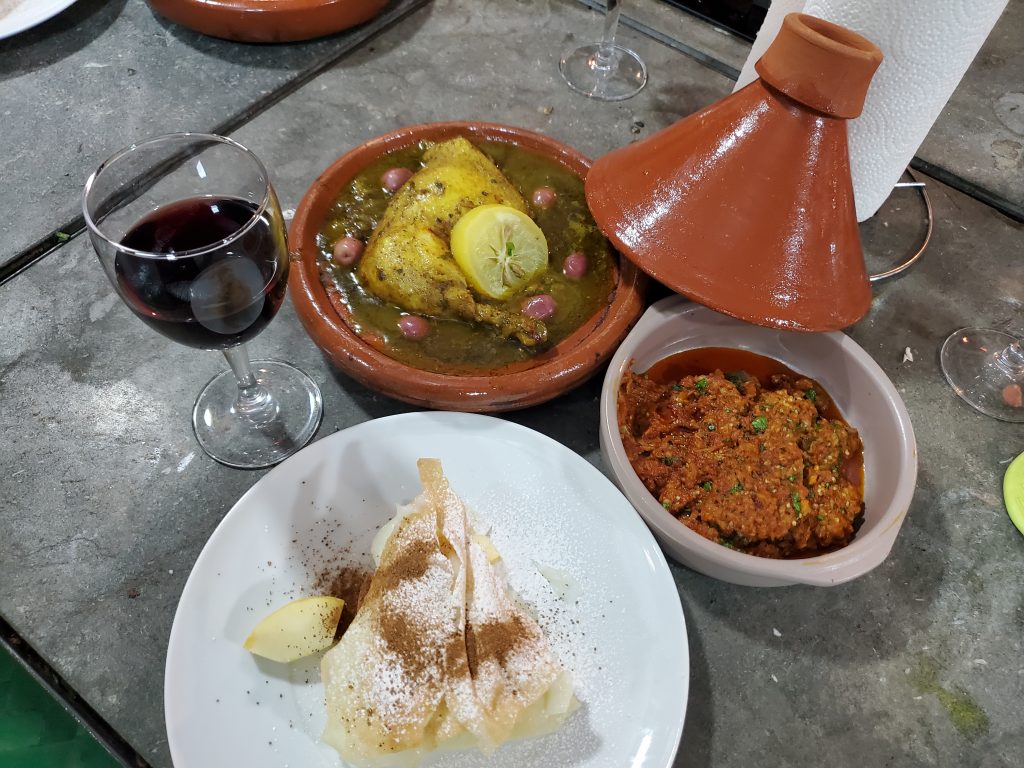
Lubna wished us all the best as she departed the class, and gave us all little fez hats as souvenirs, as well as little wicker baskets filled with plastic containers of all the spices we’d need to reconstruct her recipes she’d shared with us. I don’t think my tiny fez will fit me very well, but perhaps there’s a child at Linden who will enjoy it!
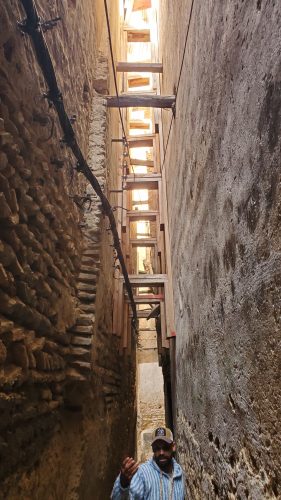


No one has commented on this post - please leave me one, I love getting feedback!
Follow this post's comments, or leave a Trackback from your site